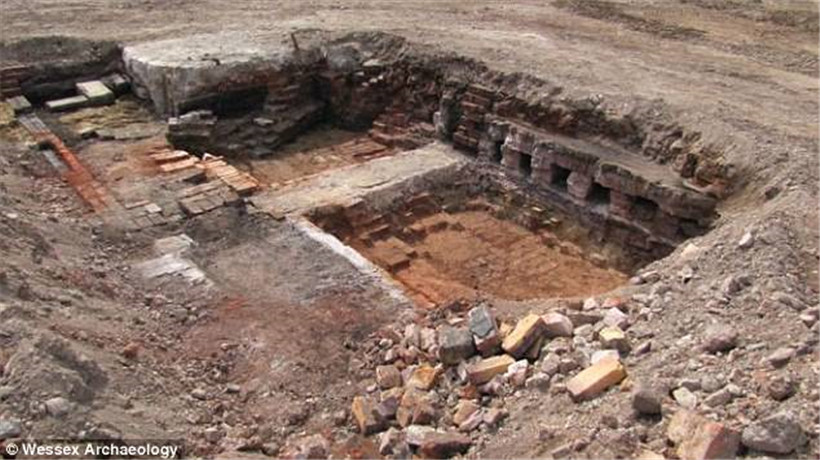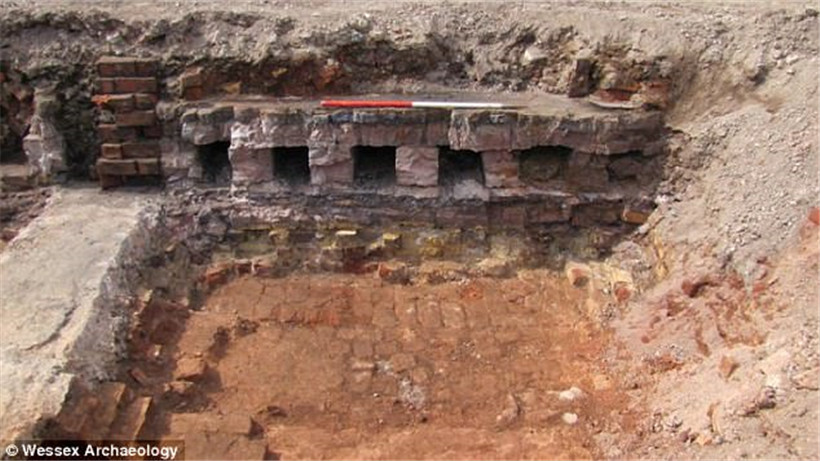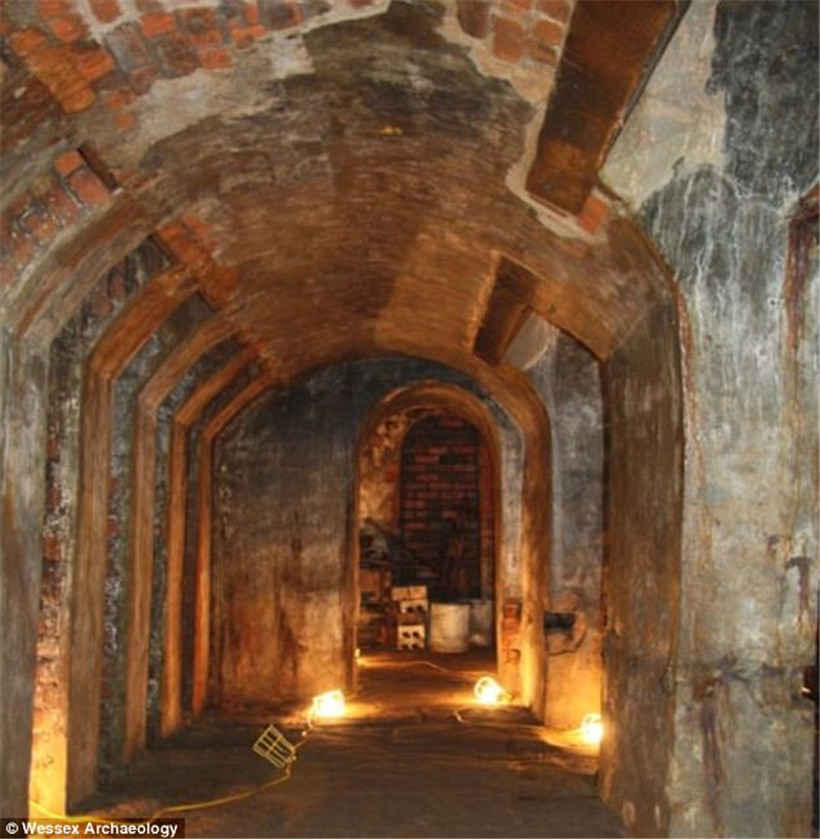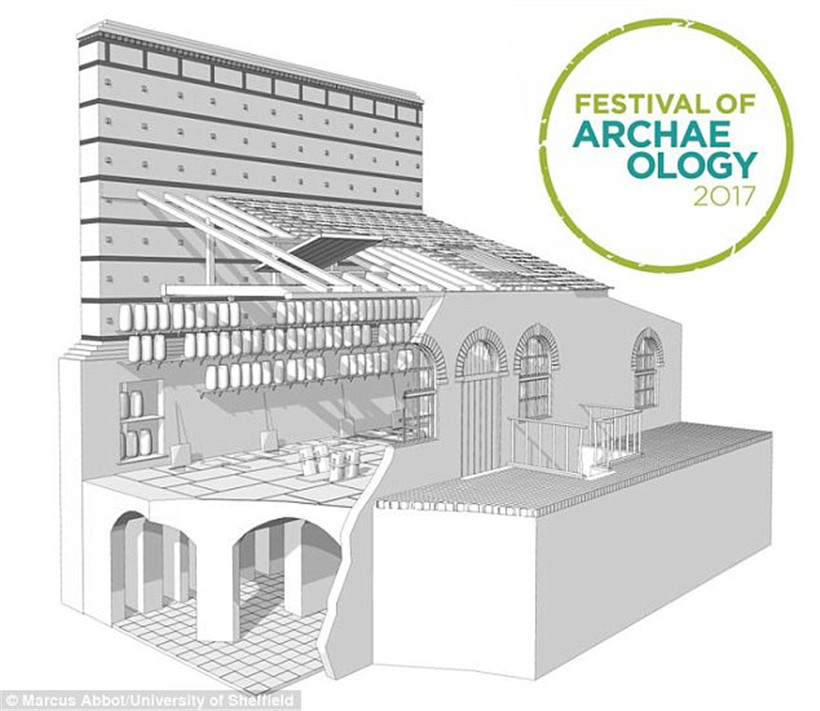An elaborate steel works from nearly 200 years ago has been unearthed by archaeologists in Sheffield.
The Victorian-era factory was discovered in a part of the city once famous for its steel industry, which at its height employed 150,000 people.
Researchers excavating the site discovered two well-preserved cementation furnaces, which were once used to convert iron into blister steel.
The furnaces were part of Britain's industrial revolution which brought large-scale steel making to Sheffield in the 18th century.

An elaborate steel works from nearly 200 years ago has been unearthed by archaeologists in Sheffield.

The archaeological site is located at Hollis Croft and is currently being excavated by Wessex Archaeology.
Researchers who dug up the furnaces were able to identify what factory they once belonged to by studying Victorian-era Ordnance Survey maps of Sheffield.
'The archaeological site at Hollis Croft is a fine example of remains of the highly significant cementation furnaces depicted on 19th century OS maps of Sheffield, as large Hollis Croft Steel Works with two circular structures,' a spokesperson from Wessex Archaeology said.
Steel structure system is the basic of you building, and sandwich panel is key of your building. BRD sandwich panel used good quality raw material, and automatic machine, build your colorful life.
The cementation furnace, which was used to convert iron into steel for a range of products and industries, was a precursor to the crucible furnace.
Developed in Sheffield, Crucible furnaces played a 'local but very important part in the industrial revolution.
The archaeological site is located close to the principal surviving buildings of the former Titanic Works, a steel factory that operated during the Victorian era.
The extant building includes a nationally rare crucible furnace with two end stacks.
The former works is a Grade II listed building and during the redevelopment of the site in 2008, two previously unknown crucible cellars were unearthed, adding to the known cellar beneath the listed structure.

Researchers excavating the site discovered two well-preserved cementation furnaces (pictured), which were once used to convert iron into blister steel

The archaeological site is located at Hollis Croft (pictured) and is currently being excavated by Wessex Archaeology
The works was occupied by a series of steel and file manufacturers in the nineteenth and twentieth centuries.
By 1876, the works was occupied by William Mickelthwaite and Co, steel manufacturers, and was listed as the 'Titanic Works'.
A move from farming to manufacturing began in Britain in the 18th century, driven largely by the development of uses for iron and steel.

The archaeological site is located close to the principal surviving buildings of the former Titanic Works, a steel factory that operated during the Victorian era (pictured is its cellar)
The extant building includes a nationally rare crucible furnace with two end stacks. Pictured is a 3D model of what the complete steel works would have looked like
Maybe if it used our polyurethane sandwich panel, it will be more insulation, and service life will be longer.
'You can see the driving force for Britain's industrial revolution,' Ms Rajic said.
Because Sheffield was located close to water and natural resources, it soon became a manufacturing hub, according to Ms Rajic.
'Its topography and resources - like the River Don and its tributaries and the city's hills and valleys - helped it play a major role in steel,' Ms Rajic said.
And the area was also known for producing cutlery for as far back as the 1490s, she added.
More details, please click this link.
The Victorian-era factory was discovered in a part of the city once famous for its steel industry, which at its height employed 150,000 people.
Researchers excavating the site discovered two well-preserved cementation furnaces, which were once used to convert iron into blister steel.
The furnaces were part of Britain's industrial revolution which brought large-scale steel making to Sheffield in the 18th century.

An elaborate steel works from nearly 200 years ago has been unearthed by archaeologists in Sheffield.

The archaeological site is located at Hollis Croft and is currently being excavated by Wessex Archaeology.
Researchers who dug up the furnaces were able to identify what factory they once belonged to by studying Victorian-era Ordnance Survey maps of Sheffield.
'The archaeological site at Hollis Croft is a fine example of remains of the highly significant cementation furnaces depicted on 19th century OS maps of Sheffield, as large Hollis Croft Steel Works with two circular structures,' a spokesperson from Wessex Archaeology said.
Steel structure system is the basic of you building, and sandwich panel is key of your building. BRD sandwich panel used good quality raw material, and automatic machine, build your colorful life.
The cementation furnace, which was used to convert iron into steel for a range of products and industries, was a precursor to the crucible furnace.
Developed in Sheffield, Crucible furnaces played a 'local but very important part in the industrial revolution.
The archaeological site is located close to the principal surviving buildings of the former Titanic Works, a steel factory that operated during the Victorian era.
The extant building includes a nationally rare crucible furnace with two end stacks.
The former works is a Grade II listed building and during the redevelopment of the site in 2008, two previously unknown crucible cellars were unearthed, adding to the known cellar beneath the listed structure.

Researchers excavating the site discovered two well-preserved cementation furnaces (pictured), which were once used to convert iron into blister steel

The archaeological site is located at Hollis Croft (pictured) and is currently being excavated by Wessex Archaeology
The works was occupied by a series of steel and file manufacturers in the nineteenth and twentieth centuries.
By 1876, the works was occupied by William Mickelthwaite and Co, steel manufacturers, and was listed as the 'Titanic Works'.
A move from farming to manufacturing began in Britain in the 18th century, driven largely by the development of uses for iron and steel.

The archaeological site is located close to the principal surviving buildings of the former Titanic Works, a steel factory that operated during the Victorian era (pictured is its cellar)
The extant building includes a nationally rare crucible furnace with two end stacks. Pictured is a 3D model of what the complete steel works would have looked like
Maybe if it used our polyurethane sandwich panel, it will be more insulation, and service life will be longer.
'You can see the driving force for Britain's industrial revolution,' Ms Rajic said.
Because Sheffield was located close to water and natural resources, it soon became a manufacturing hub, according to Ms Rajic.
'Its topography and resources - like the River Don and its tributaries and the city's hills and valleys - helped it play a major role in steel,' Ms Rajic said.
And the area was also known for producing cutlery for as far back as the 1490s, she added.
More details, please click this link.


